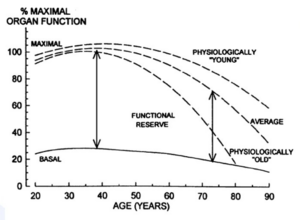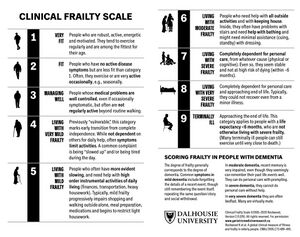Physiological reserves

Physiological reserve (or functional reserve) is a poorly-defined but important concept. It can be defined as "the potential capacity of a cell, tissue, or organ system to function beyond its basal level in response to alterations in physiologic demands[1].” In more informal terms, physiological reserve can be thought of as an organ's capacity to withstand external stressors or acute illness, like infection. Our bodies and organs have a large capacity to adapt to various external stressors, however ageing and chronic illnesses diminish this inbuilt adaptive capacity, this physiological reserve. The most common stressors are infection, trauma, dehydration, myocardial infarction, etc.
When an external stressor occurs, with infections being the most typical cause, an organ must increase its function beyond the basal level to continue to function "through" the stressor. If the organ is unable to increase its function to meet this increased demand, decompensation occurs, which may manifest as (among others):

- Delirium (due to reduced physiological reserve of the brain)
- Exacerbation of chronic heart failure (due to reduced physiological reserve of the heart)
- Acute kidney injury (due to reduced physiological reserve of the kidney)
- Death
Young and healthy people have large physiological reserves. Their organs can function well even if something happens that requires more of the organs, such as an infection.
Physiological reserve decreases naturally with age, but elderly who are physically unfit or have chronic illnesses have reduced physiological reserve compared to healthier elderly. There can be large variations in physiological reserves in elderly.
Frailty

Frailty is another poorly-defined but important concept. It can be defined as reduced capacity to respond to stressors, caused by a decline in physiological reserves. Frailty mostly affect elderly, but severely chronically ill young people can also be frail. The opposite term of frail is robust or physical resilience.
It's important to know the patient's frailty status as it may be important for the patients prognosis and treatment. It can be used to prevent undertreatment of robust elderly, and to prevent overtreatment of frail elderly.
Being frail increases mortality and morbidity. Frailty is the reason why a simple pneumonia or urinary tract infection can be lethal for elderly but is rarely more than an inconvenience for young people.
Evaluation
There exist multiple screening tools and indexes to stratify frailty, but in clinical situations, the clinical frailty scale (CFS) is often used, as is the simple test of walking speed. A walking speed of <0.8 m/s over 4 meters is a strong predictor of frailty.
Natural course
Following a stressor or acute illness, there are three possible outcomes:
- The function returns to the baseline function (rare for frail people, common for robust people)
- The function recovers a bit, but does not quite return to baseline (most common for frail people)
- The stressor or illness is too much for the organism to endure, and death occurs
- ↑ Physical Resilience: Not Simply the Opposite of Frailty - PMC (nih.gov)
